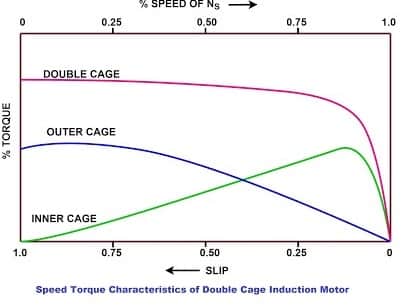A.C. induction motor starting torque is very low as compared to DC motor starting torque. Also, during acceleration, the induction motor produces torque pulsation. As a result, there is noise and vibration in the machine during the starting of the motor. The induction motor should meet the starting torque demand of the driven equipment in order to have a smooth starting. Therefore, we need to adopt ways to improve the starting torque of AC induction motors. In the later section, we shall study how to improve the starting torque of the induction motor.
The induction motor draws a large starting current, but produces very low starting torque about 1.5 to 2.5 times the starting torque. The reason for low starting torque is the poor power factor of the rotor circuit. At the start, the rotor inductance is very high as compared to the rotor resistance. A squirrel cage induction motor draws about 5 to 7 times the current of its full load current.
The induction motor and transformer both function on the principle of Faraday’s law of electromagnetic induction. The squirrel cage induction motor is just like a transformer with its secondary winding short circuit. This is the reason why an induction motor is also called a rotating transformer. Therefore, an induction motor takes a large current at the start.
It is not advisable to start a large rating induction motor directly on full line voltage. It causes a large voltage drop in the upstream power network and affects the other motors and electrical equipment connected to the electrical system.
There are some methods of improving starting torque of the induction motor. But, it needs a selection of certain parameters at the motor design stage. A better trade-off between starting torque and efficiency of the motor is necessary for optimum design of the motor.
There are four ways to improve the starting torque of an induction motor.
Methods to improve the starting torque of Induction Motor
There are four ways to improve the starting torque of an induction motor.
- Internal Rotor Resistance
- External Rotor Resistance
- Double Cage Rotor Design
- Variable voltage & Variable Frequency
1. Internal Rotor Resistance
The starting and running torque of the induction motor depends on the rotor resistance. The higher rotor resistance causes an improvement of the power factor.

From above, it is clear that the starting torque increase with an increase of rotor resistance. However, the rotor copper loss (I2R) increases, and consequently the motor efficiency decrease.
2. External Rotor Resistance for improving starting torque
The slip ring induction motor has the provision of adding an external circuit to its rotor circuit. The full resistance value comes in the rotor circuit at the time of start, and gradually resistance is cut off automatically. on reaching full speed, the rotor winding is a short circuit.
3. Double Cage Rotor for improving starting torque
The double cage rotor has two cages rotor. The outer cage has high resistance and the inner cage has low resistance. The outer cage resistance is about 5 times the inner cage resistance.

The rotor current flows through the outer cage at starting of the motor, and the motor produces high starting torque. When the motor reaches its full speed, most of the rotor current flows through the inner cage. Therefore, the deep bar double cage induction motor produces more starting torque.
4. Variable Voltage/ Frequency
A variable frequency drive (VFD) can control the torque of the induction motor. The torque depends on the flux in the motor air gap. The flux is proportional to the ratio of volt/Hz(V/f). Thus, the motor torque depends on the ratio of V/f. Generally, the V/f ratio is constant to deliver constant torque for the entire speed range.
V/f ratio can be kept high at starting instant of the motor. The higher V/f ratio produces more starting torque. After acceleration up to a certain speed, V/f ratio is set at the rated V/f of the motor. The higher starting torque is possible for a limited period of time because if kept for a longer time, the motor core saturates.
Related Posts